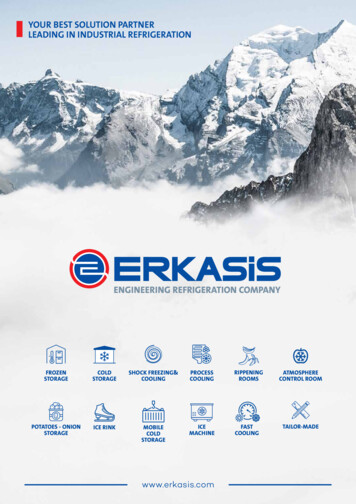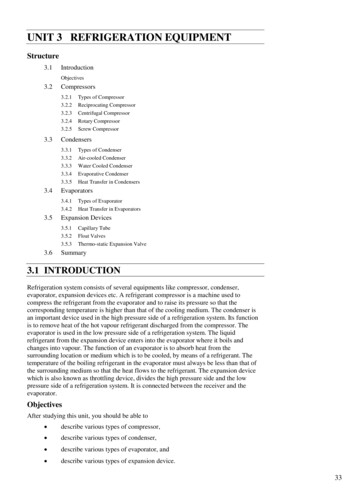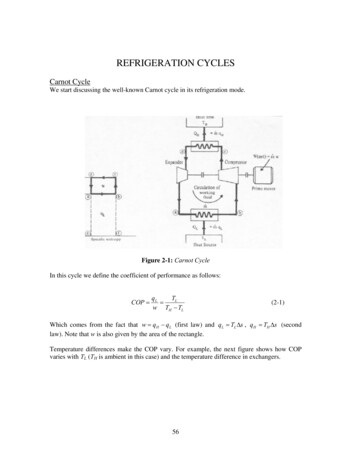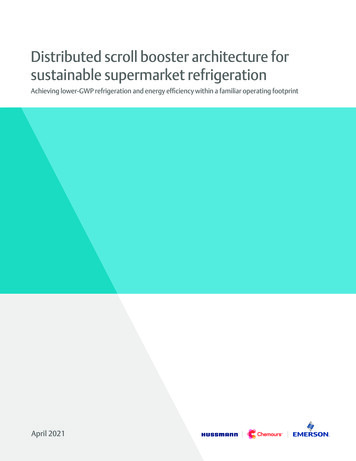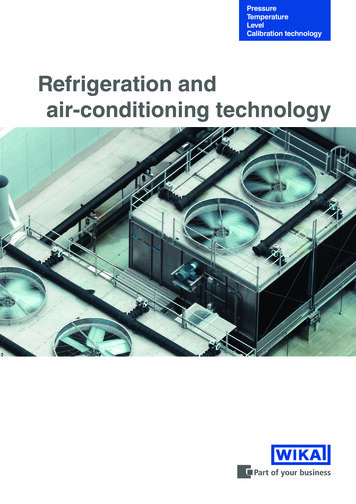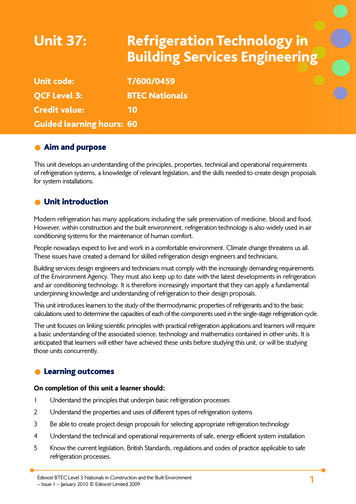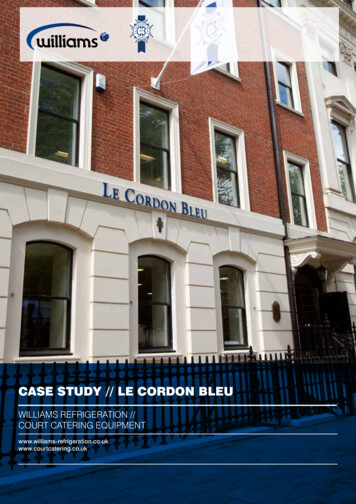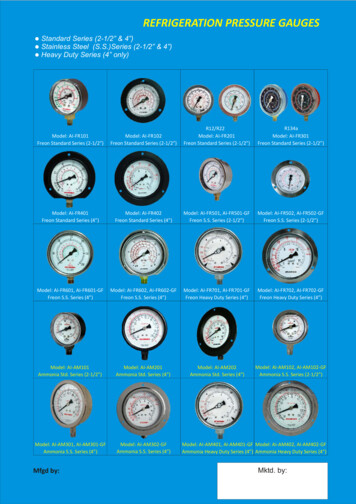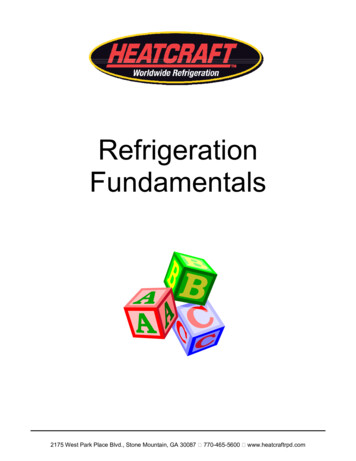
Transcription
REFRIGERATIONSYSTEMS ANDAPPLICATIONS
REFRIGERATIONSYSTEMS ANDAPPLICATIONSSecond Editionİbrahim DinçerFaculty of Engineering and Applied ScienceUniversity of Ontario Institute of Technology (UOIT)Mehmet KanoğluDepartment of Mechanical EngineeringUniversity of GaziantepA John Wiley and Sons, Ltd., Publication
This edition first published 2010 2010 John Wiley & Sons, LtdFirst Edition published in 2003Registered officeJohn Wiley & Sons Ltd, The Atrium, Southern Gate, Chichester, West Sussex, PO19 8SQ, United KingdomFor details of our global editorial offices, for customer services and for information about how to apply for permission toreuse the copyright material in this book please see our website at www.wiley.com.The right of the author to be identified as the author of this work has been asserted in accordance with the Copyright,Designs and Patents Act 1988.All rights reserved. No part of this publication may be reproduced, stored in a retrieval system, or transmitted, in any formor by any means, electronic, mechanical, photocopying, recording or otherwise, except as permitted by the UK Copyright,Designs and Patents Act 1988, without the prior permission of the publisher.Wiley also publishes its books in a variety of electronic formats. Some content that appears in print may not be availablein electronic books.Designations used by companies to distinguish their products are often claimed as trademarks. All brand names andproduct names used in this book are trade names, service marks, trademarks or registered trademarks of their respectiveowners. The publisher is not associated with any product or vendor mentioned in this book. This publication is designedto provide accurate and authoritative information in regard to the subject matter covered. It is sold on the understandingthat the publisher is not engaged in rendering professional services. If professional advice or other expert assistance isrequired, the services of a competent professional should be sought.Library of Congress Cataloging-in-Publication DataDinçer, İbrahim, 1964Refrigeration systems and applications / İbrahim Dinçer, Mehmet Kanoğlu. – 2nd ed.p. cm.Includes bibliographical references and index.ISBN 978-0-470-74740-7 (cloth)1. Cold storage. 2. Frozen foods. 3. Refrigeration and refrigerating machinery. I. Kanoğlu, Mehmet. II. Title.TP372.2.D56 2010621.5 6 – dc222009051239A catalogue record for this book is available from the British Library.ISBN: 978-0-470-74740-7Set in 9/11 Times by Laserwords Private Limited, Chennai, IndiaPrinted in Singapore by Markono Print Media Pte Ltd
ContentsAbout the ral Aspects of Thermodynamics, Fluid Flow and Heat TransferIntroduction1.1.1Systems of UnitsThermodynamic Properties1.2.1Mass, Length and Force1.2.2Specific Volume and Density1.2.3Mass and Volumetric Flow ic Systems1.2.7Process and Cycle1.2.8Property and State Postulate1.2.9Sensible Heat, Latent Heat and Latent Heat of Fusion1.2.10Vapor States1.2.11Thermodynamic Tables1.2.12State and Change of State1.2.13Pure Substance1.2.14Specific Heats1.2.15Specific Internal Energy1.2.16Specific Enthalpy1.2.17Specific EntropyIdeal GasesEnergy Change and Energy Transfer1.4.1Mass Transfer1.4.2Heat Transfer1.4.3WorkThe First Law of 31414152020202021
ontentsRefrigerators and Heat PumpsThe Carnot Refrigeration CycleThe Second Law of ThermodynamicsExergy1.9.1What is Exergy?1.9.2Reversibility and Irreversibility1.9.3Reversible Work and Exergy Destruction1.9.4Exergy Balance1.9.5Exergy or Second Law Efficiency1.9.6Illustrative Examples on ExergyPsychrometrics1.10.1Common Definitions in Psychrometrics1.10.2Balance Equations for Air and Water Vapor Mixtures1.10.3The Psychrometric ChartGeneral Aspects of Fluid Flow1.11.1Classification of Fluid Flows1.11.2Viscosity1.11.3Continuity EquationGeneral Aspects of Heat Transfer1.12.1Conduction Heat Transfer1.12.2Convection Heat Transfer1.12.3Radiation Heat TransferConcluding RemarksNomenclatureStudy efrigerantsClassification of Inorganic Compounds2.2.4Azeotropic Mixtures2.2.5Nonazeotropic MixturesPrefixes and Decoding of Refrigerants2.3.1Prefixes2.3.2Decoding the Number2.3.3IsomersSecondary RefrigerantsRefrigerant–Absorbent CombinationsStratospheric Ozone Layer2.6.1Stratospheric Ozone Layer Depletion2.6.2Ozone Depletion Potential2.6.3Montreal Protocol63636464646565676767676869707172747579
.63.73.8viiGreenhouse Effect (Global Warming)2.7.1Global Warming PotentialClean Air Act (CAA)2.8.1Significant New Alternatives Policy (SNAP)2.8.2Classification of SubstancesAlternative c (Zeotropic) Mixtures2.9.4Azeotropic Mixtures2.9.5Ammonia (R-717)2.9.6Propane (R-290)2.9.7CO2 (R-744)Selection of RefrigerantsThermophysical Properties of RefrigerantsLubricating Oils and Their EffectsConcluding RemarksStudy 99100103Refrigeration System ComponentsIntroductionHistory of RefrigerationMain Refrigeration SystemsRefrigeration System ComponentsCompressors3.5.1Hermetic Compressors3.5.2Semihermetic Compressors3.5.3Open Compressors3.5.4Displacement Compressors3.5.5Dynamic Compressors3.5.6Energy and Exergy Analyses of Compressors3.5.7Compressor Capacity and PerformanceCondensers3.6.1Water-Cooled Condensers3.6.2Air-Cooled Condensers3.6.3Evaporative Condensers3.6.4Cooling Towers3.6.5Energy and Exergy Analyses of CondensersEvaporators3.7.1Liquid Coolers3.7.2Air and Gas Coolers3.7.3Energy and Exergy Analyses of EvaporatorsThrottling Devices3.8.1Thermostatic Expansion Valves3.8.2Constant-Pressure Expansion 0130131132133135136137137140140141
t Valves3.8.4Capillary Tubes3.8.5Energy and Exergy Analyses of Throttling DevicesAuxiliary Devices3.9.1Accumulators3.9.2Receivers3.9.3Oil Separators3.9.4Strainers3.9.5Driers3.9.6Check Valves3.9.7Solenoid Valves3.9.8Defrost ControllersConcluding RemarksNomenclatureStudy 7147148148148152Refrigeration Cycles and SystemsIntroductionVapor-Compression Refrigeration sation4.2.4ExpansionEnergy Analysis of Vapor-Compression Refrigeration CycleExergy Analysis of Vapor-Compression Refrigeration CyclePractical Vapor-Compression Refrigeration Cycle4.5.1Superheating and Subcooling4.5.2Defrosting4.5.3Purging Air in Refrigeration Systems4.5.4Twin Refrigeration SystemAir-Standard Refrigeration Systems4.6.1Energy and Exergy Analyses of a Basic Air-StandardRefrigeration CycleAbsorption–Refrigeration Systems (ARSs)4.7.1Basic ARSs4.7.2Ammonia–Water (NH3 –H2 O) ARSs4.7.3Energy Analysis of an ARS4.7.4Three-Fluid (Gas Diffusion) ARSs4.7.5Water–Lithium Bromide (H2 O–LiBr) ARSs4.7.6The Steam Ejector Recompression ARS4.7.7The Electrochemical ARS4.7.8The Absorption-Augmented Refrigeration System4.7.9Exergy Analysis of an ARS4.7.10Performance Evaluation of an 7182184185187190190194195197203207
Contentsix4.8Concluding RemarksNomenclatureStudy ProblemsReferences20720820821855.15.25.3Advanced Refrigeration Cycles and SystemsIntroductionMultistage Refrigeration CyclesCascade Refrigeration Systems5.3.1Two-Stage Cascade Systems5.3.2Three-Stage (Ternary) Cascade Refrigeration SystemsLiquefaction of Gases5.4.1Linde–Hampson Cycle5.4.2Precooled Linde–Hampson Liquefaction Cycle5.4.3Claude Cycle5.4.4Multistage Cascade Refrigeration Cycle Used for Natural GasLiquefactionSteam Jet Refrigeration SystemsThermoelectric Refrigeration5.6.1Significant Thermal ParametersThermoacoustic RefrigerationMetal Hydride Refrigeration Systems5.8.1Operational PrinciplesSolar Refrigeration5.9.1Solar Refrigeration Systems5.9.2Solar-Powered Absorption Refrigeration Systems (ARSs)Magnetic RefrigerationSupermarket Refrigeration5.11.1Direct Expansion System5.11.2Distributed System5.11.3Secondary Loop SystemConcluding RemarksNomenclatureStudy 67273Heat PumpsIntroductionHeat Pumps6.2.1Heat Pump Efficiencies6.2.2Coefficient of Performance (COP)6.2.3Primary Energy Ratio (PER)6.2.4Energy Efficiency Ratio (EER)6.2.5Heating Season Performance Factor (HSPF)6.2.6Seasonal Energy Efficiency Ratio 95.105.115.1266.16.2
6.176.186.196.206.216.226.236.24ContentsSectoral Heat Pump Utilization6.3.1Large Heat Pumps for District Heating and CoolingHeat Pump Applications in IndustryHeat Sources6.5.1Air6.5.2Water6.5.3Soil and Geothermal6.5.4SolarClassification of Heat Pumps6.6.1Water-to-Water Heat Pumps6.6.2Water-to-Air Heat Pumps6.6.3Air-to-Air Heat Pumps6.6.4Air-to-Water Heat Pumps6.6.5Ground-to-Water and Ground-to-Air Heat Pumps6.6.6Basic Heat Pump Designs6.6.7Heat and Cold-Air Distribution SystemsSolar Heat PumpsIce Source Heat PumpsMain Heat Pump SystemsVapor-Compression Heat Pump Systems6.10.1The Cooling Mode6.10.2The Heating Mode6.10.3Single-Stage Vapor-Compression Heat Pump withSubcooler6.10.4Standard Rating Conditions for Compressors6.10.5ARI/ISO Standard 13256-1Energy Analysis of Vapor-Compression Heat Pump CycleExergy Analysis of Vapor-Compression Heat Pump CycleMechanical Vapor-Recompression (MVR) Heat Pump SystemsCascaded Heat Pump SystemsRankine-Powered Heat Pump SystemsQuasi-Open-Cycle Heat Pump SystemsVapor Jet Heat Pump SystemsChemical Heat Pump SystemsMetal Hydride Heat Pump SystemsThermoelectric Heat Pump SystemsResorption Heat Pump SystemsAbsorption Heat Pump (AHP) Systems6.22.1Diffusion Absorption Heat Pumps6.22.2Special-Type Absorption Heat Pumps6.22.3Advantages of Absorption Heat Pumps6.22.4Disadvantages of Absorption Heat Pumps6.22.5Mesoscopic Heat-Actuated Absorption Heat PumpHeat Transformer Heat Pump SystemsRefrigerants and Working Fluids6.24.1Chlorofluorocarbons 15315318319321323328328330330333334335336
i6.24.2Hydrochlorofluorocarbons (HCFCs)6.24.3Hydrofluorocarbons (HFCs)6.24.4Hydrocarbons (HCs)6.24.5Blends6.24.6Natural Working FluidsTechnical Aspects of Heat Pumps6.25.1Performance of Heat Pumps6.25.2Capacity and Efficiency6.25.3Cooling, Freezing and Defrost6.25.4Controls6.25.5Fan Efficiency and Power Requirements6.25.6Compressor Modification6.25.7Capacity Modulation6.25.8Heat Exchangers6.25.9RefrigerantsOperational Aspects of Heat PumpsPerformance Evaluation Aspects of Heat Pumps6.27.1Factors Affecting Heat Pump PerformanceGround-Source Heat Pumps (GSHPs)6.28.1Factors Influencing the Impact of GSHPs6.28.2Benefits of GSHPs6.28.3Types of GSHP Systems6.28.4Types of GSHP Open- and Closed-Loop Designs6.28.5Operational Principles of GSHPs6.28.6Installation and Performance of GSHPs6.28.7Hybrid Heat Pump Systems6.28.8Resistance to Heat Transfer6.28.9Solar Energy Use in GSHPs6.28.10 Heat Pumps with Radiant Panel Heating and Cooling6.28.11 The Hydron Heat PumpHeat Pumps and Energy SavingsHeat Pumps and Environmental ImpactConcluding RemarksNomenclatureStudy 63363365365367370370371377Heat PipesIntroductionHeat Pipes7.2.1Heat Pipe UseHeat Pipe Applications7.3.1Heat Pipe Coolers7.3.2Insulated Water Coolers7.3.3Heat Exchanger CoolersHeat Pipes for Electronics Cooling379379380382383383384385385
xii7.57.67.77.87.97.107.117.12ContentsTypes of Heat Pipes7.5.1Micro Heat Pipes7.5.2Cryogenic Heat PipesHeat Pipe Components7.6.1Container7.6.2Working Fluid7.6.3Selection of Working Fluid7.6.4Wick or Capillary StructureOperational Principles of Heat Pipes7.7.1Heat Pipe Operating Predictions7.7.2Heat Pipe ArrangementHeat Pipe Performance7.8.1Effective Heat Pipe Thermal ResistanceDesign and Manufacture of Heat Pipes7.9.1The Thermal Conductivity of a Heat Pipe7.9.2Common Heat Pipe Diameters and LengthsHeat-Transfer LimitationsHeat Pipes in HVAC7.11.1Dehumidifier Heat Pipes7.11.2Energy Recovery Heat PipesConcluding RemarksNomenclatureStudy 8399401402404405406406407410412412413415Appendix A – Conversion Factors417Appendix B – Thermophysical Properties421Appendix C – Food Refrigeration Data439Subject Index459
About the Authorsİbrahim Dinçer is a full professor of mechanical engineering in the faculty of engineering andapplied science at University of Ontario Institute of Technology (UOIT). Renowned for his pioneering works in the area of sustainable energy technologies, he has authored and co-authorednumerous books and book chapters, more than 500 refereed journal and conference papers, andmany technical reports. He has chaired many national and international conferences, symposia,workshops, and technical meetings. He has delivered more than 150 keynote and invited lectures.He is an active member of various international scientific organizations and societies, and serves aseditor-in-chief (for International Journal of Energy Research by Wiley and International Journalof Exergy and International Journal of Global Warming by Inderscience), associate editor, regionaleditor, and editorial board member on various prestigious international journals. He is a recipientof several research, teaching, and service awards, including a Premier’s Research Excellence awardin Ontario, Canada, in 2004. He has made innovative contributions to the understanding and development of sustainable energy technologies and their implementation, particularly through exergy.He has been working actively in the areas of hydrogen and fuel cell technologies, and his grouphas developed various novel technologies or methods.Mehmet Kanoğlu is professor of mechanical engineering at University of Gaziantep. He receivedhis B.S. in mechanical engineering from Istanbul Technical University and his M.S. (1996) andPh.D. (1999) in mechanical engineering from University of Nevada, Reno, under the supervisionof Professor Yunus A. Çengel, to whom he will be forever grateful. He spent the 2006–2007academic year as a visiting professor at University of Ontario Institute of Technology, where hetaught courses and was involved in research. Some of his research areas are refrigeration systems,gas liquefaction, hydrogen production and liquefaction by renewable energy sources, geothermalenergy, energy efficiency, and cogeneration. He is the author or co-author of dozens of journal andconference papers. Professor Kanoğlu is the co-author of the book Solutions Manual to Accompany:Introduction to Thermodynamics and Heat Transfer, McGraw-Hill Inc., New York, 1997. ProfessorKanoğlu has taught courses on thermal sciences at University of Nevada, Reno, University ofOntario Institute of Technology, and University of Gaziantep. He has consistently received excellentevaluations of his teaching.
PrefaceRefrigeration is an amazing area where science and engineering meet for solving the humankind’scooling and refrigeration needs in an extensive range of applications, ranging from the cooling ofelectronic devices to food cooling, and has a multidisciplinary character, involving a combinationof several disciplines, including mechanical engineering, chemical engineering, chemistry, foodengineering, civil engineering and many more. The refrigeration industry has drastically expandedduring the past two decades to play a significant role in societies and their economies. Therefore,the economic impact of refrigeration technology throughout the world has become more impressiveand will continue to become even more impressive in the future because of the increasing demandfor refrigeration systems and applications. Of course, this technology serves to improve livingconditions in countless ways.This second edition of the book has improved and enhanced contents in several topics, particularlyin advanced refrigeration systems. It now includes study problems and questions at the end ofeach chapter, which make the book appropriate as a textbook for students and researchers inacademia. More importantly, it now has comprehensive energy and exergy analyses presented inseveral chapters for better and performance improvement of refrigeration systems and applications,which make it even more suitable for industry. Coverage of the material is extensive, and theamount of information and data presented is sufficient for several courses, if studied in detail. It isstrongly believed that the book will be of interest to students, refrigeration engineers, practitioners,and producers, as well as people and institutions that are interested in refrigeration systems andapplications, and that it is also a valuable and readable reference text and source for anyone whowishes to learn more about refrigeration systems and applications and their and analysis.Chapter 1 addresses general concepts, fundamental principles, and basic aspects of thermodynamics, psychrometrics, fluid flow and heat transfer with a broad coverage to furnish the readerwith background information that is relevant to the analysis of refrigeration systems and applications. Chapter 2 provides useful information on several types of refrigerants and their environmentalimpact, as well as their thermodynamic properties. Chapter 3 delves into the specifics of refrigeration system components and their operating and technical aspects, analysis details, utilizationperspectives and so on, before getting into refrigeration cycles and systems. Chapter 4 presents acomprehensive coverage on refrigeration cycles and systems for various applications, along withtheir energy and exergy analyses. Chapter 5 as a new chapter provides enormous material onadvanced refrigeration cycles and systems for numerous applications with operational and technical details. There are also illustrative examples on system analyses through energy and exergy,which make it unique in this book. Chapter 6 deals with a number of technical aspects relatedto heat pump systems and applications, energy and exergy analyses and performance evaluationof heat pump systems, new heat pump applications and their utilization in industry, and groundsource heat pump systems and applications. Chapter 7 is about heat pipes and their micro- andmacro-scale applications, technical, design, manufacturing, and operational aspects of heat pipes,heat pipe utilization in HVAC applications, and their performance evaluation.Incorporated through this book are many wide-ranging examples which provide useful information for practical applications. Conversion factors and thermophysical properties of various
xviPrefacematerials, as well as a large number of food refrigeration data, are listed in the appendices inthe International System of Units (SI). Complete references are included with each chapter todirect the curious and interested reader to further information.İbrahim DinçerMehmet Kanoğlu
AcknowledgementsWe are particularly thankful to various companies and agencies which contributed documents andillustrations for use in the first edition of this book. These valuable materials helped cover the mostrecent information available with a high degree of industrial relevance and practicality. We stillkeep most of them in the second edition as long-lasting materials.We are grateful to some of our colleagues, friends and graduate students for their feedback andassistance for the first and the current editions of this book.We acknowledge the support provided by our former and current institutions.Also, we sincerely appreciate the exemplary support provided by Nicky Skinner and Debbie Coxof John Wiley & Sons in the development of this second edition, in many countless ways, fromthe review phase to the final product.Last, but not least, we would like to take this opportunity to thank our families who have beena great source of support and motivation, and for their patience and understanding throughout thepreparation of this second edition.İbrahim DinçerMehmet Kanoğlu
1General Aspectsof Thermodynamics, Fluid Flowand Heat Transfer1.1 IntroductionRefrigeration is a diverse field and covers a large number of processes ranging from cooling to airconditioning and from food refrigeration to human comfort. Refrigeration as a whole, therefore,appears complicated because of the fact that thermodynamics, fluid mechanics, and heat transferare always encountered in every refrigeration process or application. For a good understanding ofthe operation of the refrigeration systems and applications, an extensive knowledge of such topicsis indispensable.When an engineer or an engineering student undertakes the analysis of a refrigeration systemand/or its application, he or she should deal with several basic aspects first, depending upon the typeof the problem being studied, which may be of thermodynamics, fluid mechanics, or heat transfer.In conjunction with this, there is a need to introduce several definitions and concepts before movinginto refrigeration systems and applications in depth. Furthermore, the units are of importance in theanalysis of such systems and applications. One should make sure that the units used are consistentto reach the correct result. This means that there are several introductory factors to be taken intoconsideration to avoid getting lost inside. While the information in some situations is limited, it isdesirable that the reader comprehends these processes. Despite assuming that the reader, if he orshe is a student, has completed necessary courses in thermodynamics, fluid mechanics, and heattransfer, there is still a need for him or her to review, and for those who are practicing refrigerationengineers, the need is much stronger to understand the physical phenomena and practical aspects,along with a knowledge of the basic laws, principles, governing equations, and related boundaryconditions. In addition, this introductory chapter reviews the essentials of such principles, laws,and so on, discusses the relationships between different aspects, and provides some key examplesfor better understanding.We now begin with a summary of the fundamental definitions, physical quantities and their units,dimensions, and interrelations. We then proceed directly to the consideration of fundamental topicsof thermodynamics, fluid mechanics, and heat transfer.Refrigeration Systems and Applications 2010 John Wiley & Sons, Ltdİbrahim Dinçer and Mehmet Kanoǧlu
2Refrigeration Systems and Applications1.1.1 Systems of UnitsUnits are accepted as the currency of science. There are two systems: the International Systemof Units (Le Système International d’Unitès), which is always referred to as the SI units, and theEnglish System of Units (the English Engineering System). The SI units are most widely usedthroughout the world, although the English System is the traditional system of North America. Inthis book, the SI units are primarily employed.1.2 Thermodynamic Properties1.2.1 Mass, Length and ForceMass is defined as a quantity of matter forming a body of indefinite shape and size. The fundamentalunit of mass is the kilogram (kg) in the SI and its unit in the English System is the pound mass(lbm). The basic unit of time for both unit systems is the second (s). The following relationshipsexist between the two unit systems:1 kg 2.2046 lbm or1 lbm 0.4536 kg1 kg/s 7936.6 lbm/h 2.2046 lbm/s1 lbm/h 0.000126 kg/s1 lbm/s 0.4536 kg/sIn thermodynamics the unit mole (mol) is commonly used and defined as a certain amount ofsubstance containing all the components. The related equation ism(1.1)n Mif m and M are given in grams and gram/mol, we get n in mol. If the units are in kilogram and kilogram/kilomole, n is given in kilomole (kmol). For example, 1 mol of water, having a molecular weight of18 (compared to 12 for carbon-12), has a mass of 0.018 kg and for 1 kmol, it becomes 18 kg.The basic unit of length is the meter (m) in the SI and the foot (ft) in the English System, whichadditionally includes the inch (in.) in the English System and the centimeter (cm) in the SI. Theinterrelations are1 m 3.2808 ft 39.370 in.1 ft 0.3048 m1 in. 2.54 cm 0.0254 mForce is a kind of action that brings a body to rest or changes the direction of motion (e.g., apush or a pull). The fundamental unit of force is the newton (N).1 N 0.22481 lbf or 1 lbf 4.448 NThe four aspects (i.e., mass, time, length, and force) are interrelated by Newton’s second law ofmotion, which states that the force acting on a body is proportional to the mass and the accelerationin the direction of the force, as given in Equation 1.2:F ma(1.2)Equation 1.2 shows the force required to accelerate a mass of 1 kg at a rate of 1 m/s2 as1 N 1 kg m/s2 .
General Aspects of Thermodynamics, Fluid Flow and Heat Transfer3It is important to note that the value of the earth’s gravitational acceleration is 9.80665 m/s2 inthe SI system and 32.174 ft/s2 in the English System, and it indicates that a body falling freelytoward the surface of the earth is subject to the action of gravity alone.1.2.2 Specific Volume and DensitySpecific volume is the volume per unit mass of a substance, usually expressed in cubic meters perkilogram (m3 /kg) in the SI system and in cubic feet per pound (ft3 /lbm) in the English System.The density of a substance is defined as the mass per unit volume and is therefore the inverse ofthe specific volume:1(1.3)ρ vand its units are kg/m3 in the SI system and lbm/ft3 in the English System. Specific volume is alsodefined as the volume per unit mass, and density as the mass per unit volume, that isV(1.4)mmρ (1.5)VBoth specific volume and density are intensive properties and are affected by temperature andpressure. The related interconversions arev 1 kg/m3 0.06243 lbm/ft3or1 lbm/ft3 16.018 kg/m31 slug/ft3 515.379 kg/m31.2.3 Mass and Volumetric Flow RatesMass flow rate is defined as the mass flowing per unit time (kg/s in the SI system and lbm/s in theEnglish system). Volumetric flow rates are given in m3 /s in the SI system and ft3 /s in the Englishsystem. The following expressions can be written for the flow rates in terms of mass, specificvolume, and density:V̇(1.6)ṁ V̇ ρ vṁV̇ ṁv (1.7)ρ1.2.4 PressureWhen we deal with liquids and gases, pressure becomes one of the most important components.Pressure is the force exerted on a surface per unit area and is expressed in bar or Pascal (Pa). 1 baris equal to 105 Pa. The related expression isP FA(1.8)The unit for pressure in the SI denotes the force of 1 N acting on 1 m2 area (so-called Pascal ) asfollows:1 Pascal (Pa) 1 N/m2
4Refrigeration Systems and ApplicationsThe unit for pressure in the English System is pounds force per square foot, lbf/ft2 . The followingare some of the pressure conversions:1 Pa 0.020886 lbf/ft2 1.4504 10 4 lbf/in.2 4.015 10 3 in water 2.953 10 4 in Hg1 lbf/ft2 47.88 Pa1 lbf/in.2 1 psi 6894.8 Pa1 bar 1 105 PaHere, we introduce the basic pressure definitions, and a summary of basic pressure measurementrelationships is shown in Figure 1.1.1.2.4.1Atmospheric PressureThe atmosphere that surrounds the earth can be considered a reservoir of low-pressure air. Its weightexerts a pressure which varies with temperature, humidity, and altitude. Atmospheric pressure alsovaries from time to time at a single location, because of the movement of weather patterns. Whilethese changes in barometric pressure are usually less than one-half inch of mercury, they need tobe taken into account when precise measurements are essential.1 standard atmosphere 1.0133 bar 1.0133 105 Pa 101.33 kPa 0.10133 MPa 14.7 psi 29.92 in Hg 760 mmHg 760 Torr.1.2.4.2Gauge PressureThe gauge pressure is any pressure for which the base for measurement is atmospheric pressureexpressed as kPa as gauge. Atmospheric pressure serves as reference level for other types of pressuremeasurements, for example, gauge pressure. As shown in Figure 1.1, the gauge pressure is eitherpositive or negative, depending on its level above or below the atmospheric pressure level. At thelevel of atmospheric pressure, the gauge pressure becomes zero.Pressure gauge P Pabs,p – PatmPressurePatmVacuum gauge P Patm – Pabs,nPabs,nAtmospheric pressure0Figure 1.1Illustration of pressures for measurement.
General Aspects of Thermodynamics, Fluid Flow and Heat Transfer1.2.4.35Absolute PressureA different reference level is utilized to obtain a value for absolute pressure. The absolute pressurecan be any pressure for which the base for measurement is full vacuum, being expressed in kPaas absolute. In fact, it is composed of the sum of the gauge pressure (positive or negative) and theatmospheric pressure as follows:kPa (gauge) atmospheric pressure kPa (absolute)(1.9)For example, to obtain the absolute pressure, we simply add the value of atmospheric pressure of101.33 kPa at sea level. The absolute pressure is the most common one used in thermodynamiccalculations despite the pressure difference between the absolute pressure and the atmosphericpressure existing in the gauge being read by most pressure gauges and indicators.1.2.4.4VacuumA vacuum is a pressure lower than the atmospheric one and occurs only in closed systems, exceptin outer space. It is also called the negative gauge pressure. As a matter of fact, vacuum is thepressure differential produced by evacuating air from the closed system. Vacuum is usually dividedinto four levels: (i) low vacuum representing
5.4.4 Multistage Cascade Refrigeration Cycle Used for Natural Gas Liquefaction 241 5.5 Steam Jet Refrigeration Systems 250 5.6 Thermoelectric Refrigeration 252 5.6.1 Significant Thermal Parameters 254 5.7 Thermoacoustic Refrigeration 256 5.8 Metal Hydride Refrigeration Systems 257 5.8.1 Operational Principles 258 5.9 Solar Refrigeration 260
